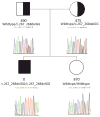Genetic studies of craniofacial anomalies: clinical implications and applications
- PMID: 19627523
- PMCID: PMC4617229
- DOI: 10.1111/j.1601-6343.2009.01455.x
Genetic studies of craniofacial anomalies: clinical implications and applications
Abstract
The objective of the study was to overview the role of genetic research in fostering translational studies of craniofacial diseases of dental interest. Background information is presented to illustrate influences affecting genetic research studies of Mendelian diseases. Genetic studies of amelogenesis imperfecta, dentinogenesis imperfecta, hereditary gingival fibromatosis and Papillon Lefèvre syndrome are reviewed. Findings are presented to illustrate how translational applications of clinical and basic research may improve clinical care. Clinical and basic science research has identified specific genes and mutations etiologically responsible for amelogenesis imperfecta, dentinogenesis imperfecta, hereditary gingival fibromatosis and Papillon Lefèvre syndrome. These findings are enabling researchers to understand how specific genetic alterations perturb normal growth and development of dental tissues. Identification of the genetic basis of these conditions is enabling clinicians and researchers to more fully understand the etiology and clinical consequences of these diseases of dental importance. Findings from genetic studies of dental diseases provide a basis for diagnostic genetic testing and development of therapeutic intervention strategies directed at the underlying disease etiology. These studies are advancing our understanding of the development of dental tissues in health and disease. The dental community must consider how to incorporate these developments into effective disease prevention paradigms to facilitate the diagnosis and treatment of individuals with genetic diseases.
Figures




References
-
- Online Mendelian Inheritance in Man, OMIM (TM) McKusick-Nathans Institute of Genetic Medicine, Johns Hopkins University; Baltimore, MD: National Center for Biotechnology Information, National Library of Medicine; Bethesda, MD: Oct 15, 2008. World Wide Web URL: http://www.ncbi.nlm.nih.gov/omim/
-
- Bailleul-Forestier I, Molla M, Verloes A, Berdal A. The genetic basis of inherited anomalies of the teeth. Part 1: clinical and molecular aspects of non-syndromic dental disorders. Eur J Med Genet. 2008;51:273–91. - PubMed
-
- Hart TC, Pallos D, Bozzo L, Cortelli J. Evidence of genetic heterogeneity for hereditary gingival fibromatosis. J Dent Res. 2000;79:1758–64. - PubMed
-
- Gorlin RJ, Cohen MM, Hennekam RCM. Syndromes of the Head and Neck. 4. New York: Oxford University Press; 2001. p. 1332.
-
- Domingo DL, Freeman AF, Davis J, Puck JM, Tianxia W, Holland SM, et al. Novel intraoral phenotypes in hyperimmunoglobulin-E syndrome. Oral Dis. 2008;14:73–81. - PubMed
Publication types
MeSH terms
Grants and funding
LinkOut - more resources
Full Text Sources
Other Literature Sources
Medical

